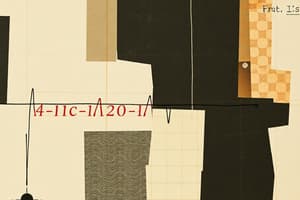Podcast
Questions and Answers
Which financial statement shows a firm's accounting value on a particular date?
Which financial statement shows a firm's accounting value on a particular date?
- Statement of retained earnings
- Cash flow statement
- Income statement
- Balance sheet (correct)
How are assets classified on the balance sheet?
How are assets classified on the balance sheet?
- As tangible or intangible
- As current or fixed (correct)
- As long-term or short-term
- As reliable or unreliable
What is the first thing listed on the right side of the balance sheet?
What is the first thing listed on the right side of the balance sheet?
- Equity
- Expenses
- Assets
- Liabilities (correct)
What is the formula for calculating the balance sheet equation?
What is the formula for calculating the balance sheet equation?
Why does the balance sheet always balance?
Why does the balance sheet always balance?
Match the following terms with their correct definitions:
Match the following terms with their correct definitions:
Match the following classifications with the correct asset types:
Match the following classifications with the correct asset types:
Match the following terms with their correct descriptions:
Match the following terms with their correct descriptions:
Match the following parts of the balance sheet equation with their correct definitions:
Match the following parts of the balance sheet equation with their correct definitions:
Match the following terms with their correct explanations:
Match the following terms with their correct explanations:
Flashcards are hidden until you start studying
Study Notes
Financial Statements
- The balance sheet presents a firm's accounting value on a specific date, reflecting what the company owns and owes.
Asset Classification on the Balance Sheet
- Assets are classified into current assets (cash or items expected to be converted to cash within a year) and non-current assets (long-term investments, property, and equipment).
Right Side of the Balance Sheet
- Liabilities are the first item listed on the right side of the balance sheet, detailing the company's obligations.
Balance Sheet Equation
- The balance sheet equation is Assets = Liabilities + Equity, establishing the relationship between what a company owns and owes.
Balance Sheet Consistency
- The balance sheet always balances because every transaction affects both sides of the equation, ensuring that total assets equal total claims.
Terminology and Definitions
- Assets represent resources owned by a company that hold economic value.
- Liabilities represent obligations or debts that the company is required to settle.
- Equity reflects the ownership interest in the assets after deducting liabilities.
Classification of Asset Types
- Current Assets include cash, accounts receivable, and inventory.
- Non-current Assets encompass property, plant, and equipment, as well as intangible assets like patents.
Descriptions of Balance Sheet Parts
- Assets are resources that provide future economic benefits.
- Liabilities are debts or obligations arising from past transactions.
- Equity represents the residual interest of the owners after liabilities are deducted from assets.
Studying That Suits You
Use AI to generate personalized quizzes and flashcards to suit your learning preferences.




